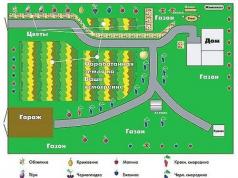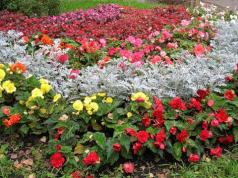This tip is for those with small areas. And every spring the question arises before gardeners: plant the entire plot with vegetables or still allocate a place for flowers. Believe me, the site looks dull without them.
Usually we plant adorable flowers on the site so that our eyes look at them and the soul rejoices! So it turns out that you can make your soul happy with growing vegetables and flowers. It turns out that the beauty of flowers can be easily combined with practical benefits! After all, many flowers, thanks to substances released into the soil, are able to repel pests! So, let's get to know these characters better and find out for which plants they are capable of becoming a reliable rear and which vegetables they will protect from pests.

It would seem that this extravagant flower can only delight! But no ... Petunia is not enough! She fights with all her might against almost all pests and diseases of legumes. Plant her next to them and you won't regret it!
Marigold
It turns out that these "plush" flowers secrete substances that are destructive for insidious nematodes and small soil worms that attempt  for cucumbers and potatoes. Plant the marigolds next to them and be calm!
for cucumbers and potatoes. Plant the marigolds next to them and be calm!
Green peas are a favorite delicacy of insect pests of the weevil and moth. They will "grind" him at once, we will not have time to blink an eye. To protect peas from the invasion of these gluttons, experienced summer residents also advise planting charming marigold flowers nearby. They will defend the peas. This plant will begin to release into the soil special substances that are not tolerated by harmful insects. Therefore, there will be no need to worry about peas with such "protection".
Calendula

The adorable flower-marigold is the main enemy of the Colorado potato beetle! Plant marigolds interspersed with potatoes, and she will courageously defend him. She is also a "weapon" against slugs, which usually attack cabbage. Therefore, it is worth "settling" a flower and next to it.
Plant tansy

Tansy grows along roads, on meadows, on forest edges ... It blooms for a long time - from July to September. It can be used fresh, or it can be prepared to take advantage of this raw material in spring. The aerial part of the wee is cut off during flowering and dried under a canopy.
But it is better to plant this plant in your area. You can - near the gazebo or bench, and mosquitoes with flies and midges will not annoy you. And also - a couple of plants in the beds. Carved leaves and yellow flowers - tansy buttons, collected in corymbose inflorescences, will decorate the vegetable garden, and various pests (flea beetles, butterflies - rats with their egg-laying ...) will not be allowed to the crops and in the cages.
If you plant it under the trees that it can help, then it will definitely not spoil the garden, it will only bring benefits. The essential oils secreted by this plant are not to the liking of ants, which are especially harmful to plums, cherries, apple trees, strawberries, and strawberries. Therefore, it will be great if tansy begins to coexist with them!
The entire aerial part of this perennial camphor-smelling plant has insecticidal properties. And this is obligatory but necessary take advantage of.
Infusion of tansy copes well with apple and plum fruit, aphids and gooseberry moth. To prepare it, fill half a bucket with chopped stems, leaves and flowers, fill with hot water to the very top, leave for a day or two, and then strain. Spray trees and bushes immediately after flowering 3-4 times at weekly intervals. For better adhesion, add to the infusion of green soap (40 g per 10 L of water).
It is good to spray roses with this infusion.
Tansy is also a medicinal plant, so there is a double benefit.
Nasturtium
 This bright flower is to everyone's liking, except for ... the white woman - the main pest of cabbage. "Invite" nasturtium to live side by side with your favorite vegetable. She will establish her own order in the beds and will not let enemies into the cabbage!
This bright flower is to everyone's liking, except for ... the white woman - the main pest of cabbage. "Invite" nasturtium to live side by side with your favorite vegetable. She will establish her own order in the beds and will not let enemies into the cabbage!
And in order for the cabbage butterfly to fly around the cabbage plantings, sow dill around the perimeter of the garden. The pest does not tolerate its scent. " This is certainly not a flower, but a garden bed in this combination will look great.
chamomile
 This beauty is suitable not only for fortune telling! It turns out that a gentle and quivering-looking chamomile is a vicious enemy of aphids, moths, which impudently encroach on berry bushes. Protect them by planting a chamomile next door.
This beauty is suitable not only for fortune telling! It turns out that a gentle and quivering-looking chamomile is a vicious enemy of aphids, moths, which impudently encroach on berry bushes. Protect them by planting a chamomile next door.
Experienced summer residents assure that 1 defender flower is enough for 3-4 plants.
And if you have allocated space for flowers, take it with other flowering plants .. And then your garden will be full of an enviable variety of colors.
Plant euphorbia, marigolds, and daffodils along the borders of the site. These plants secrete a substance
which moles cannot stand, so the little animals avoid digging holes under and next to them.









